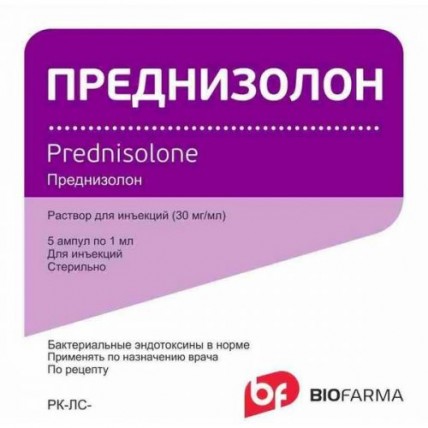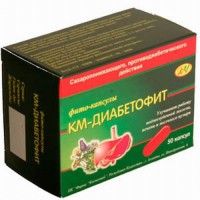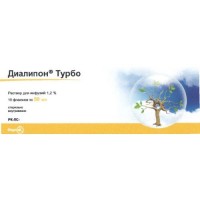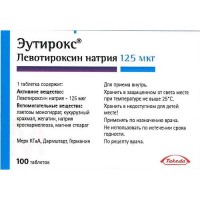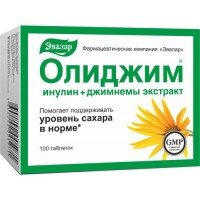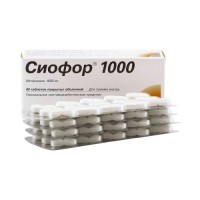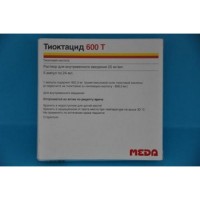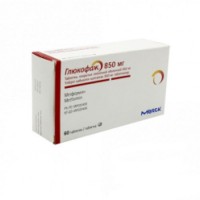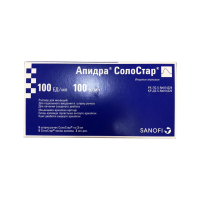Prednisolone 30 mg / ml 1ml 5's solution for injection in ampoules
- $9.00
Out Of Stock
The instruction for medical use of medicine Prednisolonum the Trade name Prednisolonum the International unlicensed name Prednisolonum Dosage Form Solution for injections of 30 mg/ml on 1 ml Structure One ampoule of solution contains active agent - phosphate sodium Prednisolonum in terms of Prednisolonum of 30 mg excipients: sodium hydrophosphate of anhydrous 0.50 mg of sodium dihydrophosphate a dihydrate of 0.35 mg propylene glycol of 150.0 mg water for injections up to 1 ml the Description Transparent colourless or almost colourless solution. Pharmacotherapeutic group Corticosteroids for system use. Glucocorticosteroids. Prednisolonum. ATX H02A B06 code. The pharmacological Pharmacokinetics At properties intramuscular introduction it is quickly soaked up in blood. The pharmacological effect of Prednisolonum considerably is late in comparison with achievement of the maximum level of drug in blood and develops in 2-8 hours. In plasma the most part of Prednisolonum contacts transcortinum (kortizolsvyazyvayushchy globulin), and at process saturation - albumine. At decrease in synthesis of protein the decrease in the connecting ability of albumine is observed that can cause increase in free fraction of Prednisolonum and, as a result, manifestation of its toxic action from usual therapeutic the dosed Elimination half-life in adults - 2-4 hours, at children – is shorter. It Biotransformirutsya by oxidation mainly in a liver and also in kidneys, a small intestine, bronchial tubes. The oxidized forms glyukuronizirutsya or sulphated and in the form of conjugates are removed by kidneys. About 20% of Prednisolonum are excreted from an organism by kidneys in not changed look, a small part - is allocated with bile. In liver diseases the metabolism of Prednisolonum slows down and decreases extent of its linking with proteins of plasma that leads to increase in elimination half-life of drug. Pharmacodynamics Anti-inflammatory, antiallergic, immunosuppressive and antishock drug. Anti-inflammatory effect of drug is caused by the fact that in rather high doses oppresses activity of fibroblasts, synthesis of collagen, a reticuloendothelium and connective tissue (braking of a proliferative phase of inflammation), delays synthesis and accelerates catabolism of protein in muscle tissue, but increases its synthesis in a liver. Antiallergic effect of drug is caused by slowing down of development of adenoid tissue with its involution at prolonged use, decrease in number of the circulating T - and V-lymphocytes, oppression of degranulation of mast cells, suppression of products of antibodies. Immunosuppressive effect of drug is caused by oppression of activity of T - and V-lymphocytes, decrease in mass of a complement in blood and also oppression of products and effects of interleukin-2. Antishock effect of drug is caused by increase in reaction of vessels on endo- and exogenous vasoconstrictive substances, with recovery of sensitivity of receptors of vessels to catecholamines and strengthening of their hypertensive effect and also a delay of removal from an organism of sodium and water. Reduces absorption of calcium in intestines, increases washing away it from bones and excretion with kidneys. Suppresses release by a hypophysis of adrenocorticotropic hormone and b-lipotropina in this connection at long prescribing of drug the functional insufficiency of bark of adrenal glands can develop. Osteoporosis and an Icenco-Cushing syndrome are the main factors limiting long therapy with glucocorticoids including Prednisolonum. Oppresses secretion of thyritropic and follicle-stimulating hormones. In high doses can increase excitability of tissues of brain and promote reduction of the threshold of convulsive readiness. Stimulates supersecretion of hydrochloric acid and pepsin in a stomach that can lead ment of a round ulcer. Indications as a part of complex emergency treatment: - shock states (burn, traumatic, operational, toxic, cardiogenic) - at inefficiency of vasoconstrictors, plasma substituting drugs and other symptomatic therapy - allergic reactions (acute severe forms), hemotransfusionic, anaphylactic shocks, anaphylactoid reactions - respiratory diseases: chronic bronchitis (it is appointed together with antibacterial treatment) - wet brain (including against the background of a tumor of a brain or swelled connected with surgical intervention, radiation therapy or an injury of the head) - bronchial asthma (severe form), the asthmatic status - general diseases of connective tissue (system lupus erythematosus, a pseudorheumatism) - acute adrenal insufficiency - thyrocardiac crisis - an acute hepatitis, a hepatic coma - for reduction of the inflammatory phenomena and prevention of cicatricial narrowings (in poisoning with the cauterizing liquids). A route of administration and doses At the beginning of therapy by any corticosteroid it is necessary to remember the following principles. The initial dose of corticosteroids has to correspond to a necessary minimum for achievement of desirable therapeutic effect and is defined by clinical assessment. It is periodically necessary to estimate this dose as the severity of a basic disease can change, or at therapy complications can develop. The dose should be reduced to the minimum size which will support satisfactory clinical treatment response gradually. At long therapy sometimes during a stress or complications of a basic disease there can be a need for increase in a dose of corticosteroids. If long therapy by Prednisolonum (usually more than 3 weeks) has to be stopped, cancellation needs to be carried out gradually for avoidance of withdrawal. The sharp termination of therapy can lead to a lethal outcome. The dose should be reduced within weeks or months depending on a dosage, duration of therapy, a disease to which therapy, and individual reaction of the patient to treatment is directed. It is improbable that the sharp cancellation of treatment by Prednisolonum which was carried out less than 3 weeks will lead to clinically significant suppression gipotalamo - a hypophysial and adrenal system at most of patients. However it is necessary to remember that reaction to corticosteroids and shipping of their cancellation can vary over a wide range. It is necessary to consider a question of gradual cancellation even after shorter courses if during treatment higher doses, or at patients with other risk factors of development of adrenocortical insufficiency were applied. Drug represents ready solution. Its cultivation in any injection solutions is not allowed! Adults At acute conditions and as replacement therapy by the adult appoint 20-30 mg/days in an initial dose, the maintenance dose makes 5-10 mg/days. If necessary the initial dose can make 15-100 mg/days, supporting - 5 - 15 mg/days. The dose is established individually, enter slowly intravenously (in / c) or intramusculary (in oil) is deep. At acute insufficiency of adrenal glands a single dose — 100–200 mg, daily — 300–400 mg. Heavy allergic reactions: a daily dose — 100–200 mg within 3–16 days. Bronchial asthma: 75–675 mg on a course of treatment from 3 to 16 days, in hard cases increase a dose to 1400 mg by a course (with gradual reduction of a dose). Asthmatic status: a daily dose — 500–1200 mg with the subsequent reduction to a maintenance dose. Thyrocardiac crisis: a single dose — 100 mg, a daily dose — 200–300 mg, if necessary increase a dose to 1000 mg, introduction duration — usually up to 6 days. At the shock resistant to standard therapy: a single dose — 50–150 mg (in hard cases — up to 400 mg). Repeatedly enter in 3–4 h. A daily dose — 300–1200 mg (with the subsequent reduction of a dose). At acute hepatonephric insufficiency (acute poisonings, postoperative and puerperal period, etc.): on 25–75 mg/days, increase in a dose up to 300–1500 mg/days and more is possible. Pseudorheumatism and system lupus erythematosus: in addition to system reception — 75–125 mg/days within no more than 7-10 days. Acute hepatitis: on 75–100 mg/days within 7–10 days. In poisoning with the cauterizing liquids with burns of a digestive tract and upper airways: 75–400 mg/days within 3–18 days. Doses for children For children the initial dose makes 1-2 mg/kg/days in 4-6 receptions, supporting – 0.3 - 0.6 mg/kg/days Side effects Very often (& gt, 1/10), is frequent (& gt, 1/100, & lt, 1/10), infrequently (& gt, 1/1000, & lt, 1/100), is rare (& gt, 1/10000, & lt, 1/1000), is very rare (& lt, 1/10000. Generally, the frequency of development of the predicted undesirable effects, including system suppression a hypothalamus-hypophyses-adrenal glands, depends on a dose, time of appointment and duration of treatment. Undesirable effects can be minimized by use of the lowest effective dose during, as far as possible, minimum period. Very often - the increased susceptibility to an infection, aggravation of the available infection, activation of latent infection and masking of symptoms of an infection owing to immunosuppressor and anti-inflammatory effect of Prednisolonum - decrease in quantity of eosinophils, monocytes and lymphocytes - the immunosuppressor and anti-inflammatory effect leading to masking or aggravation of the existing disease - the insufficiency of adrenal glands (which is beginning with inhibition of a hypothalamus and coming to the end with a true atrophy of bark of adrenal glands) at prolonged oral administration of Prednisolonum, a withdrawal owing to insufficiency of adrenal glands (a headache, nausea, dizziness, anorexia, weakness, changes of an emotional state, apathy and inadequate reaction to stressful situations, steroid diabetes with low sensitivity to insulin, increase in level of sugar of blood at the patients who already have diabetes (100%). A growth inhibition at children as a result of disturbance of secretion of growth hormone and decrease in sensitivity to growth hormone - increase in intraocular pressure (up to 40% of the patients receiving treatment by oral drug), cataracts at 30% of patients at long-term treatment by drug orally - lung abscess at the patients having lung cancer (12%) - osteoporosis with such symptoms as a dorsodynia, decrease in mobility, an acute pain, compression fractures of vertebras and decrease in height of vertebrae, fractures of long bones (25% at long-term treatment by drug for intake, see Section 4.4), a myopathy (10%) at treatment by high doses Often - increase in quantity of leukocytes and thrombocytes - Cushing's Syndrome, including change of an adiposity (crescent-shaped face, the central obesity, a bull hump) at long purpose of oral doses above physiological (usually more than 50 mg a day), a hypopotassemia owing to deduction of sodium instead of potassium, an amenorrhea at women of childbearing age, increase in level of cholesterol, triglycerides and lipoproteins at treatment by the high doses accepted inside - euphoria, a depression, the psychosis induced by corticosteroids - hypertensia (owing to sodium deduction that leads to liquid deduction), aggravation of stagnant heart failure (as a result of sodium deduction) - the increased risk of developing tuberculosis - candidiasis of an oral cavity, strengthening of symptoms in colitis, an ileitis, a diverticulitis - a fungal infection of mucous membranes, extensions, acneform rash, formation of bruises, dermatitis, an ecchymoma, an erythema of the person, an atrophy, a hirsutism, slow healing of wounds, the increased sweating, teleangiectasias and thinning of skin, masking or deterioration in the available skin diseases. - the night polyuria Infrequently - allergic reactions - diabetes (& lt, 1%) at treatment by small doses orally, increase in level of cholesterol, triglycerides and lipoproteins at treatment by low doses orally - insomnia, mood swings, changes of the personality, a maniacal syndrome and hallucinations - a myopathy of respiratory muscles - stomach ulcers or ulcers of a colon, gastrointestinal hemorrhages (0.5%), perforation of a stomach, intestines - aseptic necrosis of a bone tissue - urinary stones owing to the increased excretion of calcium and phosphate, disturbance of secretion of sex hormones (disturbance of periods, a hirsutism, impotence), a vasculitis Seldom - risk of thrombosis owing to fibrillation - change of function of a thyroid gland - in cerebral malaria coma can last, weak-mindedness. - high risk of destruction of a cornea of an eye in a simultaneous gerpesny infection of eyes (in view of masking of this infection), glaucoma (long-term treatment by drug orally). Very seldom - ketoacidosis and a giperosmolyarny coma, manifestation of a latent hyperparathyreosis, acceleration of development of a porphyria - a syndrome of lysis of a tumor - manifestation of latent epilepsy, a brain pseudoneoplasm (benign intracranial hypertensia with such symptoms as a headache, not clear sight and disorders of vision) - an exophthalmos (after long oral drug treatment) - a cardiomyopathy with increase in risk of decrease in minute volume of heart, arrhythmia owing to a hypopotassemia - pancreatitis after long-term treatment by high doses - an epidermal necrolysis, a syndrome Stephen-Johnson Protivopokazaniya - hypersensitivity to drug components - a peptic ulcer of a stomach and/or duodenum - osteoporosis - Itsenko-Cushing's disease - tendency to a thrombembolia - a renal and/or liver failure - viral infections (including damages of eyes and skin), herpetic diseases - dekompensirovanny diabetes - an active form of tuberculosis - glaucoma, a cataract - arterial hypertension - productive symptomatology in mental diseases - psychoses, depressions - system mycoses - syphilis - a heavy myopathy (except for myasthenias) - poliomyelitis (behind an exception it is bulbar - an encephalitic form) - the vaccination period (not less than 14 days before carrying out immunization) - lymphadenitis after vaccination of BCZh - pregnancy and the period of a lactation - children's age up to 6 years - injections in the injection site (for intra articulate injections) - chronic active hepatitis with Hbs Ag-positive reaction Medicinal interactions Anticoagulants: at simultaneous use with glucocorticoids the effect of anticoagulants can amplify or decrease. Parenteral administration of Prednisolonum causes thrombolytic action of antagonists of vitamin K (fluindion, atsenokumarol). Salicylates and other non-steroidal anti-inflammatory drugs: simultaneous use of salicylates, indometacin and other non-steroidal anti-inflammatory drugs can increase the probability of formation of ulcers of a mucous membrane of a stomach. Prednisolonum reduces the level of salicylates in blood serum, increasing their renal clearance. The care at reduction of a dose of Prednisolonum at prolonged simultaneous use is necessary. Hypoglycemic drugs: Prednisolonum partially oppresses hypoglycemic effect of oral antihyperglycemic means and insulin. Inductors of liver enzymes, for example, barbiturates, Phenytoinum, pyramidon, carbamazepine and rimfampitsin increase system clearance of Prednisolonum, thus reducing effect of Prednisolonum almost twice. CYP3A4 inhibitors, for example, erythromycin, klaritromitsin, ketokonazol, diltiazem, an aprepitant, itrakonazol and Oleandomycinum increase elimination and level of Prednisolonum in blood plasma that strengthens therapeutic and side effects of Prednisolonum. Estrogen can potentsiirovat effect of Prednisolonum, slowing down his metabolism. It is not recommended to regulate Prednisolonum doses to the women applying oral contraceptives which promote not only to increase in elimination half-life, and and development of atypical immunosuppressive effect of Prednisolonum. Ftorkhinolona: simultaneous use can lead to injury of sinews. Amphotericinum B, diuretics and depletive: Prednisolonum can increase removal of potassium from an organism at patients who receive at the same time these drugs. Immunodepressants: Prednisolonum has active immunosuppressive properties which can cause increase in therapeutic effects or risk of development of different side reactions at simultaneous use with other immunodepressants. Glucocorticoids increase antiemetic efficiency of antiemetic drugs which are used in parallel at therapy protivoopukho
by the evy drugs causing vomiting. Corticosteroids can increase concentration of a takrolimus in plasma at their simultaneous use, at their cancellation the concentration of a takrolimus in plasma decreases. Immunization: glyukortikoida can reduce efficiency of immunization and increase risk of neurologic complications. Use of therapeutic (immunosuppressive) doses of glucocorticoids with live virus vaccines can increase risk of developing viral diseases. Throughout therapy vaccines of the emergency type can be applied by drug. Antikholinesterazny means: use of glucocorticoids and antikholinesterazny means can cause muscle weakness in patients with a myasthenia, especially patients with a myasthenia have gravis. Cardiac glycosides: their shipping worsens and the likelihood of developing ventricular premature ventricular contraction raises. Others: At long use the glucocorticoids can reduce effect of Somatotropinum. Cases of emergence of a sharp myopathy at use of corticosteroids for patients who at the same time receive treatment by neuromuscular transmission blockers are described (for example, pankuroniy). At simultaneous use of Prednisolonum and cyclosporine, cases of developing of spasms were noted. Antihistaminic medicines reduce effect of Prednisolonum. Prednisolonum can reduce effect of hypotensive drugs. Paracetamol - increases hepatotoxicity owing to induction of liver enzymes and formation of a toxic metabolite of paracetamol. Mitotanum and other inhibitors of function of bark of adrenal glands can cause need of increase in a dose of Prednisolonum. Acetylsalicylic acid - accelerates its removal and reduces concentration in blood (at Prednisolonum cancellation the level of salicylates in blood increases and risk of development of by-effects increases). Insulin and oral hypoglycemic drugs, antihypertensives - decreases their efficiency. Somatotropic hormone - reduces efficiency of the last, and with prazikvantely - its concentration. M-holinoblokatory (including antihistaminic drugs and tricyclic antidepressants) and nitrates - promotes increase in intraocular pressure, the Isoniazid and meksiletin - increases their metabolism (especially at 'slow' atsetilator) that leads to decrease in their plasma concentration. Adrenocorticotropic hormone strengthens effect of Prednisolonum. Ergocalciferol and parathormone interfere with development of the osteopathy caused by Prednisolonum. Cyclosporine and ketokonazol, slowing down Prednisolonum metabolism, can increase the probability of side effects in some cases. Co-administration of androgens and steroid anabolic drugs with Prednisolonum contributes to the development of peripheral hypostases and a hirsutism, appearance of eels. Antipsychotic means (neuroleptics) and Azathioprinum increase risk of developing a cataract when prescribing Prednisolonum. Co-administration of antacids reduces Prednisolonum absorption. At simultaneous use with anti-thyroid drugs decreases, and with thyroid hormones - the clearance of Prednisolonum Special instructions except for replacement therapy increases, corticosteroids work not only with medical effect, but also as palliative means thanks to the anti-inflammatory and immunosuppressor effects. Long reception, depending on a dose and duration of treatment, is connected with increase in frequency of emergence of undesirable effects. Patients who receive long therapy by corticosteroids of systemic action have to be under observation for the purpose of suppression identification gipotalamo - hypophysial and adrenal system (GGN), insufficiency of adrenal glands, Cushing's syndrome, a hyperglycemia and a glucosuria. After long therapy by corticosteroids, treatment should be cancelled smoothly for prevention of withdrawal. Adrenocortical insufficiency can remain for months after the treatment termination by corticosteroids, during the stress periods (surgery, a disease) the replacement therapy can be required. The risk of insufficiency of adrenal glands can be reduced by prescription of medicine every other day instead of daily entered dosed Corticosteroids it is necessary to appoint with care in any known infectious disease or suspicion to it. Due to the anti-inflammatory and immunosuppressor effects of corticosteroids, their use in doses of higher when comparing with necessary for physiological substitution, increases susceptibility to an infection, leads to aggravation of the available infectious disease and activation of latent infections. Anti-inflammatory action can lead to masking of symptoms until the infectious disease does not pass into the started stage. If during treatment there are new infections, it is necessary to pay special attention to inability to localize an infection. At patients with latent tuberculosis (TB) the therapy by corticosteroids can increase risk of development of TB. It is necessary to observe carefully such patients regarding reactivation of TB and if long-term treatment is required by corticosteroids, the antitubercular chemotherapy can be shown. Use of corticosteroids at active TB has to be limited to cases of transient or disseminate forms of a disease when the corticosteroid is appointed for treatment along with the corresponding antitubercular therapy. System therapy by corticosteroids can increase risk of a serious or lethal infectious disease at the persons contacting to sick viral infections, such as chicken pox or measles (patients should be warned about need to avoid contacts with sick viral infections and the immediate address to the doctor in case of contact). Corticosteroids can activate latent amoebic infections, and prior to treatment the corticosteroids recommend to exclude their existence. Prednisolonum strengthens a gluconeogenesis. Approximately at 20% of the patients receiving treatment by high doses of steroids the benign steroid diabetes with low sensitivity to insulin and a low renal threshold for glucose develops. The state is reversible at therapy cancellation. At the confirmed diabetes the treatment by corticosteroids usually leads to disturbance of balance that can be compensated by correcting of a dose of insulin. Long-term treatment by Prednisolonum influences metabolism of calcium and phosphate and increases risk of osteoporosis. Prednisolonum promotes decrease in level of calcium and phosphate that influences vitamin D level, thereby causing decrease in level of osteocalcine, dependent on a dose, in serum (protein of a bone matrix which correlates with formation of a bone). Prescribing of calcium and D3 vitamin can prevent the loss of a bone tissue induced by glucocorticoids. Therapy by Prednisolonum within several weeks causes the risk of a growth inhibition connected with reduction of secretion of growth hormone and reduced peripheral sensitivity to this hormone in children. In children's practice medicine is appointed if the expected therapeutic advantage exceeds possible risk. Corticosteroids can cause mental disturbances, including euphoria, insomnia, mood swings, a depression and psychotic trends. Long purpose of corticosteroids of systemic action can cause a back subkapsulyarny cataract and glaucoma (owing to the increased intraocular pressure) and also increase in risk of infection of eyes with infections. It is necessary to appoint corticosteroids with care at the following states: - gastrointestinal diseases, such as nonspecific ulcer colitis, diverticulitis and ileitis in connection with the probability of a perforation of a colon, abscess or other piogenic infections, obstructions of a colon, the expressed fistula, a fresh intestinal anastomosis, latent round ulcers - arterial hypertension or kongestivny diseases of the cardiac vascular system - depression of a bone - a liver disease - a hypothyroidism - a myasthenia which can lead to strengthening of a myopathy - cerebral malaria - the available lymphoid tumors as there are messages about development of a syndrome of intense lysis of a tumor after purpose of glucocorticoids - the latent epilepsy - a hyperparathyreosis as Prednisolonum can promote proyavle-a disease niya. The Mineralokortikoidny effect of Prednisolonum can lead to deduction of sodium and water with the subsequent compensatory increase in excretion of potassium in kidneys and a hypopotassemia. There can be a need for restriction of salt for food and additional administration of potassium. The patients who are at the same time receiving treatment by the diuretics removing potassium should appoint corticosteroids with care. The feature of influence of medicine on ability to run the vehicle or potentially dangerous mechanisms to the Patients accepting Prednisolonum should refrain from potentially dangerous types of activity which require special attention and speed of mental and motor reactions. Overdose Symptoms – nausea, vomiting, bradycardia, arrhythmia, strengthening of the phenomena of heart failure, cardiac arrest, a hypopotassemia, increase in arterial blood pressure, a myotonia, a hyperglycemia, a thrombembolia, acute psychosis, dizziness, a headache. development of symptoms of a hypercorticoidism is possible: increase in body weight, formation of hypostases, hypertensia, glucosuria. At children at overdose the oppression of a gipotalamo-hypophysial adrenal system, an Icenco-Cushing syndrome, decrease in excretion of growth hormone, increase in intracranial pressure is possible. Treatment - drug phase-out, symptomatic therapy, if necessary - correction of electrolytic balance. There is no specific antidote. A form of release and packing On 1 ml of drug in ampoules glass with a ring of a break of 1 ml or 2 ml. On 5 ampoules of drug put in blister strip packaging from a film polyvinylchloride which is covered with aluminum foil. On 1 blister strip packaging together with the instruction for medical use in the state and Russian languages place in a pack from cardboard bandbox (chrome ersatz). Packs put in a group container and paste the label group. To Store storage conditions in original packing for protection against influence of light at a temperature not above 25 °C. To store out of children's reach! 2 years not to use a period of storage after an expiration date. Prescription status According to the prescription the Producer/packer of LLC Federal Law BIOFARMA, Ukraine, 09100, Kiev Region, Bila Tserkva, Kiyevskaya St., 37 ph. (044) 277-36-10 The holder of the registration certificate of LLC Federal Law BIOFARMA, Ukraine
the Address of the organization accepting in the territory of the Republic of Kazakhstan claims from consumers on quality of the products responsible for post-registration observation of safety of medicine of Daulet Agro LLP Republic of Kazakhstan, Kostanay, Baytursynov St. 45, office 69 of KTRahmetova@almsklad.stopharm.kz
by the evy drugs causing vomiting. Corticosteroids can increase concentration of a takrolimus in plasma at their simultaneous use, at their cancellation the concentration of a takrolimus in plasma decreases. Immunization: glyukortikoida can reduce efficiency of immunization and increase risk of neurologic complications. Use of therapeutic (immunosuppressive) doses of glucocorticoids with live virus vaccines can increase risk of developing viral diseases. Throughout therapy vaccines of the emergency type can be applied by drug. Antikholinesterazny means: use of glucocorticoids and antikholinesterazny means can cause muscle weakness in patients with a myasthenia, especially patients with a myasthenia have gravis. Cardiac glycosides: their shipping worsens and the likelihood of developing ventricular premature ventricular contraction raises. Others: At long use the glucocorticoids can reduce effect of Somatotropinum. Cases of emergence of a sharp myopathy at use of corticosteroids for patients who at the same time receive treatment by neuromuscular transmission blockers are described (for example, pankuroniy). At simultaneous use of Prednisolonum and cyclosporine, cases of developing of spasms were noted. Antihistaminic medicines reduce effect of Prednisolonum. Prednisolonum can reduce effect of hypotensive drugs. Paracetamol - increases hepatotoxicity owing to induction of liver enzymes and formation of a toxic metabolite of paracetamol. Mitotanum and other inhibitors of function of bark of adrenal glands can cause need of increase in a dose of Prednisolonum. Acetylsalicylic acid - accelerates its removal and reduces concentration in blood (at Prednisolonum cancellation the level of salicylates in blood increases and risk of development of by-effects increases). Insulin and oral hypoglycemic drugs, antihypertensives - decreases their efficiency. Somatotropic hormone - reduces efficiency of the last, and with prazikvantely - its concentration. M-holinoblokatory (including antihistaminic drugs and tricyclic antidepressants) and nitrates - promotes increase in intraocular pressure, the Isoniazid and meksiletin - increases their metabolism (especially at 'slow' atsetilator) that leads to decrease in their plasma concentration. Adrenocorticotropic hormone strengthens effect of Prednisolonum. Ergocalciferol and parathormone interfere with development of the osteopathy caused by Prednisolonum. Cyclosporine and ketokonazol, slowing down Prednisolonum metabolism, can increase the probability of side effects in some cases. Co-administration of androgens and steroid anabolic drugs with Prednisolonum contributes to the development of peripheral hypostases and a hirsutism, appearance of eels. Antipsychotic means (neuroleptics) and Azathioprinum increase risk of developing a cataract when prescribing Prednisolonum. Co-administration of antacids reduces Prednisolonum absorption. At simultaneous use with anti-thyroid drugs decreases, and with thyroid hormones - the clearance of Prednisolonum Special instructions except for replacement therapy increases, corticosteroids work not only with medical effect, but also as palliative means thanks to the anti-inflammatory and immunosuppressor effects. Long reception, depending on a dose and duration of treatment, is connected with increase in frequency of emergence of undesirable effects. Patients who receive long therapy by corticosteroids of systemic action have to be under observation for the purpose of suppression identification gipotalamo - hypophysial and adrenal system (GGN), insufficiency of adrenal glands, Cushing's syndrome, a hyperglycemia and a glucosuria. After long therapy by corticosteroids, treatment should be cancelled smoothly for prevention of withdrawal. Adrenocortical insufficiency can remain for months after the treatment termination by corticosteroids, during the stress periods (surgery, a disease) the replacement therapy can be required. The risk of insufficiency of adrenal glands can be reduced by prescription of medicine every other day instead of daily entered dosed Corticosteroids it is necessary to appoint with care in any known infectious disease or suspicion to it. Due to the anti-inflammatory and immunosuppressor effects of corticosteroids, their use in doses of higher when comparing with necessary for physiological substitution, increases susceptibility to an infection, leads to aggravation of the available infectious disease and activation of latent infections. Anti-inflammatory action can lead to masking of symptoms until the infectious disease does not pass into the started stage. If during treatment there are new infections, it is necessary to pay special attention to inability to localize an infection. At patients with latent tuberculosis (TB) the therapy by corticosteroids can increase risk of development of TB. It is necessary to observe carefully such patients regarding reactivation of TB and if long-term treatment is required by corticosteroids, the antitubercular chemotherapy can be shown. Use of corticosteroids at active TB has to be limited to cases of transient or disseminate forms of a disease when the corticosteroid is appointed for treatment along with the corresponding antitubercular therapy. System therapy by corticosteroids can increase risk of a serious or lethal infectious disease at the persons contacting to sick viral infections, such as chicken pox or measles (patients should be warned about need to avoid contacts with sick viral infections and the immediate address to the doctor in case of contact). Corticosteroids can activate latent amoebic infections, and prior to treatment the corticosteroids recommend to exclude their existence. Prednisolonum strengthens a gluconeogenesis. Approximately at 20% of the patients receiving treatment by high doses of steroids the benign steroid diabetes with low sensitivity to insulin and a low renal threshold for glucose develops. The state is reversible at therapy cancellation. At the confirmed diabetes the treatment by corticosteroids usually leads to disturbance of balance that can be compensated by correcting of a dose of insulin. Long-term treatment by Prednisolonum influences metabolism of calcium and phosphate and increases risk of osteoporosis. Prednisolonum promotes decrease in level of calcium and phosphate that influences vitamin D level, thereby causing decrease in level of osteocalcine, dependent on a dose, in serum (protein of a bone matrix which correlates with formation of a bone). Prescribing of calcium and D3 vitamin can prevent the loss of a bone tissue induced by glucocorticoids. Therapy by Prednisolonum within several weeks causes the risk of a growth inhibition connected with reduction of secretion of growth hormone and reduced peripheral sensitivity to this hormone in children. In children's practice medicine is appointed if the expected therapeutic advantage exceeds possible risk. Corticosteroids can cause mental disturbances, including euphoria, insomnia, mood swings, a depression and psychotic trends. Long purpose of corticosteroids of systemic action can cause a back subkapsulyarny cataract and glaucoma (owing to the increased intraocular pressure) and also increase in risk of infection of eyes with infections. It is necessary to appoint corticosteroids with care at the following states: - gastrointestinal diseases, such as nonspecific ulcer colitis, diverticulitis and ileitis in connection with the probability of a perforation of a colon, abscess or other piogenic infections, obstructions of a colon, the expressed fistula, a fresh intestinal anastomosis, latent round ulcers - arterial hypertension or kongestivny diseases of the cardiac vascular system - depression of a bone - a liver disease - a hypothyroidism - a myasthenia which can lead to strengthening of a myopathy - cerebral malaria - the available lymphoid tumors as there are messages about development of a syndrome of intense lysis of a tumor after purpose of glucocorticoids - the latent epilepsy - a hyperparathyreosis as Prednisolonum can promote proyavle-a disease niya. The Mineralokortikoidny effect of Prednisolonum can lead to deduction of sodium and water with the subsequent compensatory increase in excretion of potassium in kidneys and a hypopotassemia. There can be a need for restriction of salt for food and additional administration of potassium. The patients who are at the same time receiving treatment by the diuretics removing potassium should appoint corticosteroids with care. The feature of influence of medicine on ability to run the vehicle or potentially dangerous mechanisms to the Patients accepting Prednisolonum should refrain from potentially dangerous types of activity which require special attention and speed of mental and motor reactions. Overdose Symptoms – nausea, vomiting, bradycardia, arrhythmia, strengthening of the phenomena of heart failure, cardiac arrest, a hypopotassemia, increase in arterial blood pressure, a myotonia, a hyperglycemia, a thrombembolia, acute psychosis, dizziness, a headache. development of symptoms of a hypercorticoidism is possible: increase in body weight, formation of hypostases, hypertensia, glucosuria. At children at overdose the oppression of a gipotalamo-hypophysial adrenal system, an Icenco-Cushing syndrome, decrease in excretion of growth hormone, increase in intracranial pressure is possible. Treatment - drug phase-out, symptomatic therapy, if necessary - correction of electrolytic balance. There is no specific antidote. A form of release and packing On 1 ml of drug in ampoules glass with a ring of a break of 1 ml or 2 ml. On 5 ampoules of drug put in blister strip packaging from a film polyvinylchloride which is covered with aluminum foil. On 1 blister strip packaging together with the instruction for medical use in the state and Russian languages place in a pack from cardboard bandbox (chrome ersatz). Packs put in a group container and paste the label group. To Store storage conditions in original packing for protection against influence of light at a temperature not above 25 °C. To store out of children's reach! 2 years not to use a period of storage after an expiration date. Prescription status According to the prescription the Producer/packer of LLC Federal Law BIOFARMA, Ukraine, 09100, Kiev Region, Bila Tserkva, Kiyevskaya St., 37 ph. (044) 277-36-10 The holder of the registration certificate of LLC Federal Law BIOFARMA, Ukraine
the Address of the organization accepting in the territory of the Republic of Kazakhstan claims from consumers on quality of the products responsible for post-registration observation of safety of medicine of Daulet Agro LLP Republic of Kazakhstan, Kostanay, Baytursynov St. 45, office 69 of KTRahmetova@almsklad.stopharm.kz
